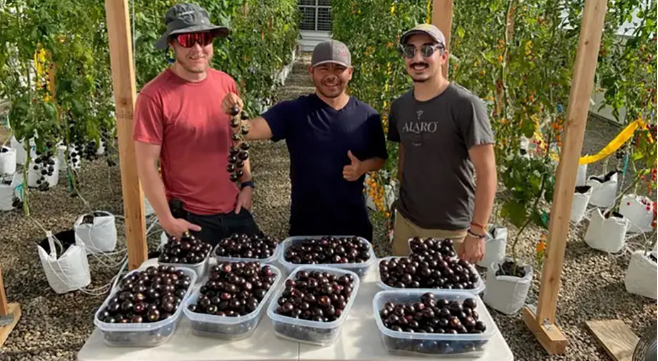May 24, 2025 | 00:45 GMT +7
May 24, 2025 | 00:45 GMT +7
Hotline: 0913.378.918
May 24, 2025 | 00:45 GMT +7
Hotline: 0913.378.918

Trays of purple tomatoes.
About the size and shape of a cherry tomato, the new tomato is a dark, gothic purple on the outside and showcases shades ranging from lavender to royal purple on the inside.
This pageantry of purples is more than just for show. The color is indicative of the nutritional value of the purple tomato and the science behind its creation.
The purple tomato was developed by professor and founder of Norfolk Healthy Produce Cathie Martin. According to Norfolk Healthy Produce CEO Nathan Pumplin, Martin was looking for ways to improve the nutrition and health attributes of foods, such as tomatoes.
Martin discovered that by combining genes from the snapdragon, an edible flower, with the tomato, a purple pigment and additional nutrients are produced in the tomato fruit.
The nutrients are known as anthocyanins, which are antioxidants found in blackberries, grapes, eggplants and other purple fruits and vegetables, Pumplin said. It is these nutrients that give certain plants their striking color.
Additionally, he noted that these antioxidants provide a variety of health benefits, such as anti-cancer and anti-flammatory properties, and aid in heart, lung and neurological health.
"The purple tomato is extremely special because it fits in our conversation right now about health and nutrition, about how important it is to improve the diet of everybody in the world, especially people in the U.S.," Pumplin said. "I think it's great for us to think about how we get more nutrition and the choices that we make around food."
Despite the benefits of anthocyanins, most Americans do not consume enough of them. Pumplin said the average American eats about 12 mg per day, when they should be eating 10-20 times the amount. This amount is equivalent to a single serving of blueberries, but most people do not eat that many blueberries.
This nutrient deficiency in the American diet is one of the reasons why Martin and her team selected the tomato for development.
According to Pumplin, Americans eat 20 times more tomatoes than they eat blueberries. This presented an opportunity for a genetic crossover between tomatoes and purple-blue fruits and vegetables.
"This is really an excellent way to get more anthocyanins, more of these purple antioxidants, into your diet every day," he said.
And of course, the million-dollar question: How does it taste?
Much like a cherry tomato, according to Pumplin.
"We really love the flavor," he said. "It's pretty low on acid, and so you get a very umami, a very savory, earthy kind of tomato flavor."
Purple tomatoes will become available in select grocery stores for the first time starting in late spring and early summer.
For people interested in testing their green thumbs when growing the purple fruit, seeds can now be purchased on the Norfolk Healthy Produce website.
Growing the purple tomato plant has been tested throughout the U.S., from California to Connecticut, Pumplin said.
"They've done extremely well. They're very hardy plants. They're very vigorous," he noted. "Really, they're just a tomato like any other tomato. So even though the fruit is purple, they're no different from other indeterminate tomatoes that growers will grow in their garden."
(Fox9)

(VAN) Alt Carbon has raised $12 million in a seed round as it plans to scale its carbon dioxide removal work in the South Asian nation.

(VAN) Attempts to bring down the price of the Japanese staple have had little effect amid a cost-of-living crisis.

(VAN) Fourth most important food crop in peril as Latin America and Caribbean suffer from slow-onset climate disaster.

(VAN) Shifting market dynamics and the noise around new legislation has propelled Trouw Nutrition’s research around early life nutrition in poultry. Today, it continues to be a key area of research.

(VAN) India is concerned about its food security and the livelihoods of its farmers if more US food imports are allowed.

(VAN) FAO's Director-General emphasises the need to work together to transform agrifood systems.

(VAN) Europe is facing its worst outbreak of foot-and-mouth since the start of the century.